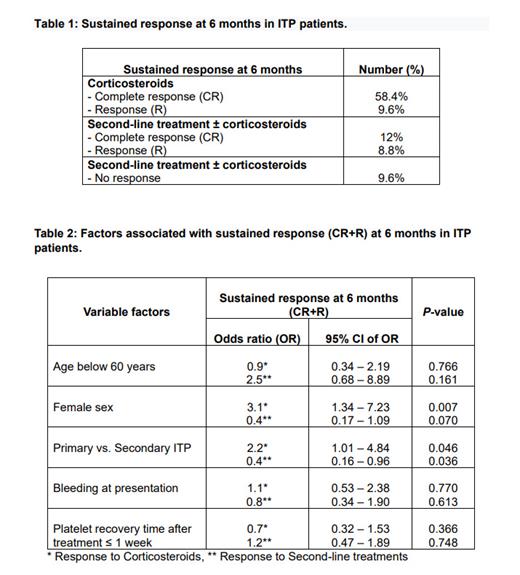Background: Immune thrombocytopenia (ITP) is an autoimmune disease resulting from platelet destruction and impaired platelet production. Some patients experience relapses or refractoriness after corticosteroid treatment, necessitating second-line treatments. The majority of adult ITP cases become chronic or relapsing. The aim of this study was to assess the clinical course and identify factors related to sustained responses to treatment in patients with ITP.
Methods: This observational retrospective cohort study was conducted from January 2013 to December 2022 at Trang Hospital, Trang Province, Thailand.
Results: A total of 125 newly diagnosed ITP patients were enrolled, with an average follow-up duration of 48.49 ± 41.49 (mean ± SD) months. The average age was 42.34 ± 18.44 years, the average platelet count was 11.66 ± 14.39 x 10 9 /L, and the average platelet recovery time after treatment was 43.14 ± 101.32 days. The mean response duration after the first-line treatment was 25.99 ± 29.39 months. The characteristics of the patients were as follows: age below 60 years (78.4%), female sex (75.2%), pregnancy (1.6%), primary ITP (67.2%), secondary ITP (32.8%), bleeding symptoms (54.4%), platelet count <10 x 10 9 /L (64%), platelet count 10-30 x 10 9 /L (28.8%), platelet count 30-50 x 10 9 /L (5.6%), platelet count >50 x 10 9 /L (1.6%), splenectomy (4%), observation only (2.4%), loss to follow-up (10.4%), and death (4%). The most common cause of secondary ITP was systemic lupus erythematosus (63%). The first-line treatment consisted of dexamethasone (70.4%), prednisolone (23.2%), and/or intravenous immunoglobulin (4%).
The clinical courses were as follows: recovery within 3 months in 68.8%, persistence in 13.6%, and chronic ITP in 17.6%. The sustained responses to corticosteroid treatment at 6 months included complete response (CR) (58.4%) and response (R) (9.6%), as shown in Table 1. Second-line treatments were required in 22.4% of cases, including colchicine (60.7%), azathioprine (35.7%), cyclophosphamide (25%), dapsone (17.8%), vincristine (10.7%), mycophenolate mofetil (7.1%), cyclosporine (3.5%), and/or eltrombopag (3.5%). The sustained responses to second-line treatments at 6 months were CR in 12% and R in 8.8%. Female sex ( P-value 0.007) and primary ITP ( P-value 0.046) were significantly associated with the sustained response (CR+R) to corticosteroids at 6 months. Secondary ITP ( P-value 0.036) was also associated with the sustained response (CR+R) to second-line treatments at 6 months (Table 2).
Conclusions: This study reveals a favorable prognosis for ITP, with a majority of patients showing sustained response (CR+R), which differs from findings in studies conducted at referral centers. Female patients and those with primary ITP are more likely to respond. Further confirmation is needed through a large prospective cohort study in community hospitals.
Disclosures
No relevant conflicts of interest to declare.


This feature is available to Subscribers Only
Sign In or Create an Account Close Modal